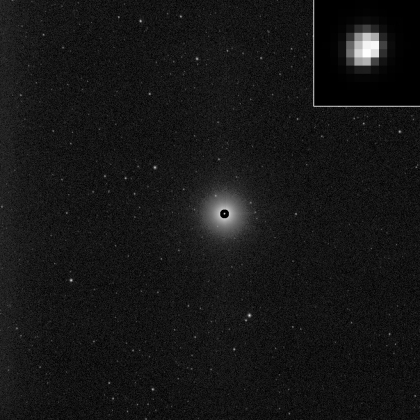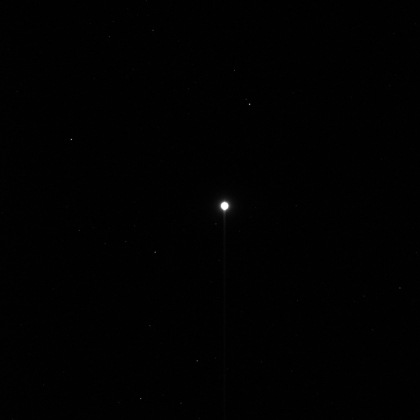Press Release 11/2011 - May 11, 2011
Land ho! A first glimpse of Vesta
The framing cameras on board the spacecraft Dawn catch sight of the mission's first scientific target.
After a flight time of three and a half years, the framing cameras on board NASA's space probe Dawn have shot their first picture of the asteroid Vesta. The protoplanet with a diameter of approximately 530 kilometers appears as a bright, round spot in front of a dark background of stars. In this early approach phase the image that was taken from a distance of 1,2 million kilometers mainly serves navigational purposes. However, when the spacecraft arrives at the asteroid Vesta in July of this year, the scientists expect much more detailed information - such as high resolution images of the asteroid's surface.
"At this point, Vesta has a diameter of only five pixels in our navigational images", says Dr. Andreas Nathues from the Max Planck Institute for Solar System Research (MPS) in Germany, framing camera lead investigator. "But in the months to come this will change dramatically". So far, NASA's Hubble Space Telescope offers the best view of the asteroid - and for example shows a huge crater on its southern hemisphere. Only Dawn, however, will be able to uncover its detailed surface properties. This will help solve the mystery of Vesta's evolutionary history. "We can't wait to begin our exploration", says Dr. Carol Raymond, Dawn-scientist from NASA's Jet Propulsion Laboratory (JPL).

|
Figure 1: This image shows the first glimpse of the giant asteroid Vesta in front of a spectacular background of stars processed to show the true size of Vesta. It was obtained by the framing camera aboard NASA's Dawn spacecraft on May 3, 2011, from a distance of about 1.2 million kilometers. Since Vesta is so bright that it outshines its starry background, the framing camera team commanded a long exposure time to make the stars visible. They corrected the resulting exaggerated size of Vesta by superimposing a short exposure image of the target asteroid, showing its true size. Vesta is the small, bright pearl in the middle of the image.
Vesta is 330 miles (530 kilometers) in diameter and the second most massive object in the asteroid belt. But, as the inset shows, Vesta is approximately five pixels across in size in Dawn's early approach images.
|
(Credits: NASA/JPL-Caltech/UCLA/MPS/DLR/IDA)
|
While approximately 4,6 billion years ago other large asteroids merged to form our solar system's planets, Vesta is an almost unchanged survivor from this early phase of planet formation. Dawn's framing cameras will now for the first time gather information on the mineralogical composition and texture of Vesta's surface and allow for topographical maps. "From the number of craters we will be able to infer the age of the surface", explains Prof. Dr. Harald Hiesinger from the Institute for Planetology of the University in Münster (Germany), who like Prof. Dr. Gerhard Neukum from the Freie Universität in Berlin participates in the analysis of the camera images. "In addition we hope to gain new insights into the volcanic evolution of Vesta", says Dr. Andreas Nathues.
The space craft Dawn has been on its way to the mission's first scientific destination, the asteroid Vesta, since September 2007. Vesto circles the Sun within the so-called asteroid belt beyond the orbit of Mars. In July 2011, Dawn will reach the asteroid and accompany it for a year. The space probe will then leave for its second target, the asteroid Ceres. The arrival is scheduled for 2015.

|
Figure 2: This is the first, unprocessed image obtained by NASA's Dawn spacecraft of the giant asteroid Vesta in front of a background of stars. It was obtained by Dawn's framing camera on May 3, 2011, from a distance of about 1.2 million kilometers. Vesta is inside the white glow at the center of the image. The giant asteroid reflects so much sunlight that its size is dramatically exaggerated at this exposure.
This and other images help Dawn fine-tune navigation during its approach to Vesta, with arrival expected on July 16, 2011.
|
(Credits: NASA/JPL-Caltech/UCLA/MPS/DLR/IDA)
|
The Dawn mission to Vesta and Ceres is managed by NASA's Jet Propulsion Laboratory for NASA's Science Mission Directorate (SMD), Washington. It is a project of the Discovery Program, managed for SMD by NASA's Marshall Space Flight Center, Huntsville, Ala. The University of California, Los Angeles, is responsible for overall Dawn mission science. Orbital Sciences Corporation of Dulles, Va., designed and built the Dawn spacecraft. The framing cameras have been developed and built under the leadership of the Max Planck Institute for Solar System Research, Katlenburg-Lindau, Germany, with significant contributions by the German Aerospace Center (DLR) Institute of Planetary Research, Berlin, and in coordination with the Institute of Computer and Communication Network Engineering, Braunschweig. The framing camera project is funded by the Max Planck Society, DLR, and NASA.
Contact
Dr. Birgit Krummheuer
Press and Public Relations
Max Planck Institute for Solar System Research
Max-Planck-Straße 2
37191 Katlenburg-Lindau
Tel.: 05556 979 462
Fax: 05556 979 240
Mobil: 0173 3958625
Email: krummheuer mps.mpg.de
mps.mpg.de
Dr. Andreas Nathues
Framing Camera Lead Investigator
Max Planck Institute for Solar System Research
Max-Planck-Straße 2
37191 Katlenburg-Lindau
Tel.: 05556 979 433
Fax: 05556 979 240
Email: nathues mps.mpg.de
mps.mpg.de
